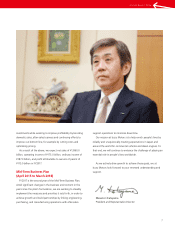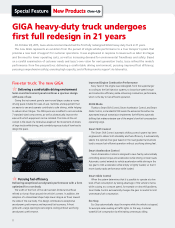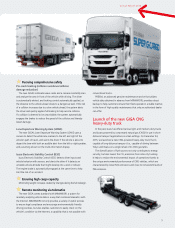Isuzu 2016 Annual Report Download - page 19
Download and view the complete annual report
Please find page 19 of the 2016 Isuzu annual report below. You can navigate through the pages in the report by either clicking on the pages listed below, or by using the keyword search tool below to find specific information within the annual report.
17
Management’s Discussion and Analysis of Financial Condition and Results of Operation
Offsetting these were factors including ¥25.1 billion in growth
strategy-related investments, ¥6.1 billion in increased costs associated
with growth in sales, and ¥4.1 billion in sales and model mix
fluctuations.
As a result, Isuzu’s operating margin fell to 8.9%, compared to
9.1% for the previous year.
4. Non-operating gains/losses
In fiscal 2016, Isuzu posted a non-operating gain of ¥15.1 billion, a
decrease of ¥1.1 billion from the previous year.
Equity-method investment income fell ¥500 million from the
previous year to ¥9.1 billion.
A drop in interest and dividends earned spurred an increase in net
interest (interest and dividends earned minus interest expenses) of
¥3.2 billion, a deterioration of ¥700 million compared to the previous
year. This increase was augmented by a foreign exchange gain of ¥2.6
billion, a decrease of ¥1.3 billion from the previous year. At the same
time, payments made in connection with legal settlements fell ¥1.0
billion.
5. Extraordinary gains/losses
In fiscal 2015, Isuzu posted an extraordinary loss of ¥3.1 billion,
reflecting extraordinary losses including loss on the disposal of
noncurrent assets and impairment loss, and extraordinary income
including gain on sale of noncurrent assets and gain on sales of
subsidiaries’ stock.
In fiscal 2016, Isuzu posted an extraordinary loss of ¥300 million,
an improvement of ¥2.8 billion from the previous year. Key factors
reflect extraordinary losses, including loss on disposal of noncurrent
assets and impairment loss, and extraordinary income, including gain
on sale of noncurrent assets and loss on step acquisitions.
6. Taxes
Isuzu’s net tax expense in fiscal 2015 including current income
taxes and deferred income taxes was ¥44.2 billion. In fiscal 2016, the
net tax expense was ¥50.0 billion.
7. Non-controlling interests
Non-controlling interests consist primarily of profits returned
to the non-controlling shareholders of Isuzu’s locally incorporated
subsidiaries in the ASEAN region, China, and North America, and its
Japanese parts manufacturers. Non-controlling interests in fiscal 2016
decreased to ¥21.6 billion, compared to ¥22.9 billion in fiscal 2015.
8. Profit attributable to owners of parent
The Group posted a profit attributable to owners of parent of
¥114.6 billion in fiscal 2016, a decline of ¥2.3 billion from the previous
year. Profit attributable to owners of parent per share came to ¥138.43.
(3) Financial conditions
1. Cash flow
Isuzu generated cash and cash equivalents (“net cash”) of ¥259.2
billion in fiscal 2016, down ¥46.2 billion from the previous year. Net
The following provides an analysis of the financial condition and
results of operation in fiscal 2016. The following information
contains forward-looking statements that reflect the judgment of
management as of June 29, 2016.
(1) Significant accounting policies and estimates
The consolidated financial statements of the Isuzu Group are prepared
in accordance with generally accepted accounting principles of
Japan. In the preparation of these statements, the amounts recorded
for items including allowance for doubtful accounts, inventory,
investments, income taxes, retirement benefits, and provision
for product warranties are estimates that reflect the judgment of
management. Due to the uncertain nature of estimates, in some cases
actual results may vary from initial estimates, and this may have a
negative impact on business results.
(2) Results of operations
1. Overview of fiscal 2016
The Company posted sales of ¥1,926.9 billion (up 2.5% from the
previous year), operating income of ¥171.5 billion (up 0.3% from the
previous year), ordinary income of ¥186.6 billion (down 0.4% from
the previous year), and profit attributable to owners of parent of
¥114.6 billion (down 2.0% from the previous year).
2. Net Sales
In fiscal 2016, Isuzu’s consolidated-basis sales rose 2.5% from the
previous year to ¥1,926.9 billion.
In the domestic commercial vehicle market, Isuzu maintained its
high market share through the introduction of products with superior
fuel efficiency and economy, capturing 33.4% of the medium-duty
and heavy-duty truck markets (down 1.1 points from the previous
year) and 39.2% of the light-duty (2-3 ton) truck market (down 1.4
point from the previous year). Demand for medium- and heavy-duty
trucks rose to 88,263 (up 0.7% from the previous year) and demand
for light-duty trucks rose to 98,161 (up 1.7% from the previous year)
due in part to brisk replacement demand and economic stimulus
measures put in place by the national government. As a result,
domestic sales rose to ¥693.1billion (up 1.7% from the previous year).
Sales in Asia rose 3.2% from the previous year to ¥541.4 billion.
Although the market environment in Thailand remained sluggish,
the Group continued to maintain its high share with 33% of the Thai
market.
North American sales rose 12.2% from the previous year to ¥141.2
billion, reflecting local promotional measures as well as growth in
total demand due to robust economic conditions in the region.
Sales to other regions grew 0.7% to ¥551.0 billion, reflecting
increased sales, particularly in Oceania, Europe, and other regions.
3. Operating income
Operating income in fiscal 2016 was ¥171.5 billion, up 0.3% from
a year earlier.
Cost reduction activities and exchange rate fluctuations caused
by the weakness of the yen contributed ¥21.0 billion and ¥7.5
billion, respectively, while economic fluctuations added ¥7.3 billion.
























